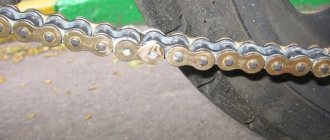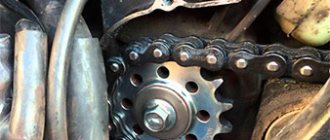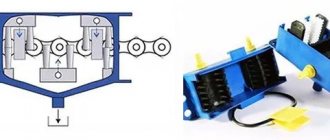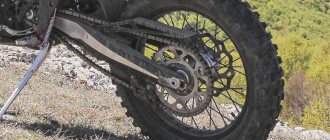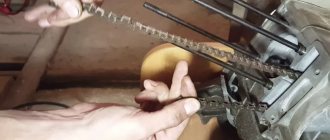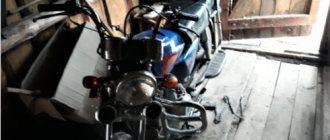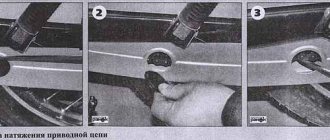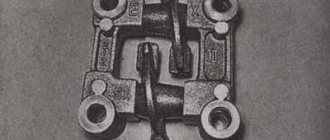I must say right away that the chain drive itself has been known for a long time; now it is not the only option, but it is still popular to this day. Its main advantages are ease of installation and maintenance, high efficiency, affordable price, and the ability to change the so-called without unnecessary hassle. gear ratio. There are also disadvantages, of course. The main disadvantage is that the chain stretches, wears out and therefore sag - you have to tighten it. And it needs to be lubricated regularly.
Each motorcycle chain of a decent brand has a proprietary index that can immediately answer a number of questions for an informed buyer. Thus, the most widespread products are those with indices 428, 520, 525 and 530. The first number in them is the chain pitch (the distance between the axes of the link fastenings), and the next two are the width (exactly the internal width where the teeth go).
No tightening or loosening should be done to compensate for extra or missing links. When buying a replacement chain, most motorcycle owners take their old one and count how many links there are, and then look for an analogue. There is an option to change the gear ratio and/or drive sprocket, then the number of links will have to be increased/decreased.
According to the type of seal, all motorcycle chains are divided into sealed and sealless. Actually, the name eloquently indicates the features of the device. The stuffing box type is marked according to the type of seal: O-ring, X-ring, W- or Z-ring. The index indicates the service life and friction losses. The oil seals keep the lubricant in the rollers, reducing wear, which greatly increases the life of the entire chain. Naturally, you need to lubricate a motorcycle chain with a compound specially designed for this purpose, and not with any lubricant.
There are several types of oil seals, they differ primarily in their cross-section. At one time, it was thanks to oil seals that the need for protective covers disappeared and the open system gained popularity - now almost all motorcycles are like this. And sealless chains have become niche - they are popular in sports and for models with small cubic capacity.
Moto chains for motorcycles. Marking and selection of chains.
In our motorcycle showrooms and online store you can buy DID, Iris and JT (Bikealert) motorcycle chains of all popular sizes and modifications, as well as individual connecting links for them.
When selecting a chain for your motorcycle, you should be guided by the following parameters: type (size) of chain and chain length (number of links).
Chain type
The type of chain is determined by the geometric dimensions of its individual links, the chain pitch - the distance between the axes of the rollers, and has a generally accepted marking system for all manufacturers. The most common types of chains on modern production motorcycles are: 530, 525, 428 and 420. Also on sports motorcycles, small-capacity vehicles and ATVs you can find motorcycle chains 630, 520, 532, 420 and 415.
The three-digit digital marking contains information about the pitch and width of the chain links. The first number divided by 8 is the chain pitch in inches. For example, for a 525 chain it is 5/8” or 15.875 mm. The second and third numbers indicate the internal width between the side plates of the link. For a 525 chain the formula is 2.5/8” or 7.9375mm. In practice, there is usually no need to make any measurements and it is enough to use the spare parts catalog for your motorcycle or the catalog of the chain manufacturer and select the desired option, focusing on the three-digit index. If you don’t have such information at hand, you can find out the type of chain using the above formulas, converting millimeters to inches in reverse order (1 inch = 25.4 mm) and multiplying them by 8.
Chain length
The chain length can vary even on the same motorcycle model, depending on how many teeth the drive and driven sprockets are installed with. In catalogs, information on sprockets and the number of links is usually given for the standard factory gear ratio. The number of links in the chain marking corresponds to the number of chain rollers.
Chain lock
As a rule, a chain installed on a motorcycle at the factory does not have a lock and all links are riveted in the same way. This is done to improve reliability. In the case of chains supplied as spare parts, there can be two options: either with a connecting link for riveting or with a split lock. Of course, a correctly riveted chain without a lock will be preferable in every sense than a lock. However, it will require a special squeezing device for riveting and “direct hands”, or contact the service.
Depending on the manufacturer, the marking of motorcycle chains may contain additional symbols indicating certain design features.
The letters O, X, W, Z indicate the type of seal
or oil seal, used in chain rollers that retains lubricant in the roller while protecting it from water and dirt. At one time, it was the appearance of such seals that made it possible to switch to open operation of the chain, without bulky protective covers. O-ring is the simplest seal in the form of a regular ring. X, W and Z are more advanced and now common options for seals, which, although more expensive than the O-ring, are significantly superior to them in efficiency and durability.
The service life of the chain largely depends on the quality of this seal. You can still find chains without seals at all, for example in professional motorsports or on cheap Chinese mopeds and motorcycles. It is clear that the service life of such chains is limited to almost one racing weekend or season, respectively.
In addition to the above parameters, chain manufacturers also offer various color options: a motorcycle chain can be standard black, nickel-plated, with partially or completely gold-plated links, or colored.
Some manufacturers, usually well-known and leading in the development of new technologies in this industry, may also offer some of their own know-how in chains that exceed the standard ones in strength and durability, reflecting this in one way or another in the marking.
Online program for calculating the chain length when replacing motorcycle sprockets with non-standard ones.
The program, as before, can be easily downloaded here and taken with you on a trip to places where there is no Internet. If you have the Internet, it is of course easier to use an online program to calculate the chain length here on this page. This program is suitable for all types of motorcycles. Its advantage is that even in the most remote wilds of our homeland, if problems arise with the chain, you can try to find analogues of the chain from Soviet motorcycles, which are still very common. We’ll talk separately about the interchangeability of motorcycle chains of different brands later.
First, how to use the program .
In the first four windows we drive in the original chain pitch, the number of teeth of the driving and driven chain, and the number of links in the original. All this information should be found in the manual for your motorcycle. For a Honda cb400 motorcycle on an NC-39 frame, the values will look like this: Original chain pitch: 525 Number of teeth for the drive sprocket: 14 Number of teeth for the driven chain: 44 Original chain length: 108
Then we drive in those values, chains and stars that are being replaced. Let's say we put a driven star on the same sibishka, which is 1 tooth larger. Then we need to enter the following values: Chain pitch (replacement): 525 Number of drive sprocket teeth (replacement): 14 Number of driven sprocket teeth (replacement): 45
We get the length of the new chain to be 109 links. This does not happen, so we round up to 110 units. We always round up to the nearest even number of chain links.
The program automatically changes the maximum speed of the motorcycle when replacing the sprockets with non-standard ones. The general rule is this: the larger the rear (driven) sprocket, the lower the maximum speed, the larger the front (drive) sprocket, the higher the maximum speed. And vice versa.
Features of chains from EK Chain
The brand is considered the flagship of its field. It was this brand that first created the O-ring drive, and now offers a range of different types. And for several decades now, motorcycle chains produced by EK Chains have been considered among the highest quality.
The simplest option is considered the standard: a sealless chain for small-capacity motorcycles. Yes, it stretches quickly and requires frequent lubrication. And you need to clean it often. But friction losses are very small. And if you need a stronger analogue, you can purchase the so-called. high-load chain of the same brand. Made from more durable materials, suitable for motorcycles with a volume of up to 0.65 liters.
The O-Ring type O-ring chain of the SRO series is equipped with round seals to retain lubricant and protect friction pairs from dirt. As a result, the product life is half that of sealless ones. But there is also a minus: turning the links increases friction, which reduces power. Ideal for motorcycles with a volume of 0.75 liters.
X-shaped rings in the range of this brand are available in the QX-Ring and Quadra-X chains. There are ventilation holes to keep the chains cooler. And friction is 40% less, thanks to a smaller contact surface. And the seal is better. According to test results, chains with Quadra-X can last approximately half as long as O-Ring. The branded SRX2 series is recommended for motorcycles with a volume of up to 1 liter.
This brand also has products produced using Zero Stretch technology - labeled ZST. They are guaranteed not to stretch during the first thousand kilometers. Initially they were created to preserve the length of the chain for the entire period of operation.
It is also worth mentioning a couple of classes: MVXZ2 and ZVX3 The first of them are chains for powerful “iron horses” with a volume of 1-1.4 liters, and the second are chains with record tensile strength. For example, the original version of the 520ZVX3 holds 11,100 kg per hundred links, and weighs only 2.2 kg - it can be safely installed in any motorcycle used under heavy load.
Dimensions of motorcycle chains and their interchangeability.
Motorcycle chains have three main sizing options. These are the chain pitch, roller width and roller diameter. We can find out the value of two of these parameters from the chain markings; these are the chain pitch and the roller width. This is a standard for marking circuits, so these values are marked the same by all manufacturers. For example, let's take a 525 circuit. In this case, the first number 5 means the chain pitch, and the next two numbers, 25, determine the width of the roller.
The chain pitch is the distance between the axes passing through the center of two adjacent rivets.
We have rollers on the rivets. They are the ones who determine how long the chain will run. The width of the roller is determined between the two inner chain plates clamping the roller.
I wanted to take a visual photograph, but right after IMIS-2013 I broke my lens, so I had to draw...
Everything seems to be clear with the roller diameter.
There is also the “rule of eight”, according to which you can calculate the chain pitch length and roller width. For example, a 530 chain - the distance between the axes of the rollers is 5/8″ = 15.875 mm, and the width of the roller (not to be confused with the diameter, this is the height of the roller cylinder) 3/8″ = 9.53 mm. For a 525 chain, these dimensions are 5/8″ and 2.5/8″, respectively. Why even calculate the length in millimeters if everything is clear from the markings? Only to find a substitute among the chains from Soviet motorcycles, no matter how unlikely this scenario is.
Types of motorcycle chains depending on the type of oil seals.
Probably the fact that there are O-ring, X-ring and Z-ring chains for motorcycles, and that these same O-ring, X-ring and Z-ring are types of chain roller seals, everyone knows.
The most interesting thing is that it doesn’t end there, almost every major manufacturer of motorcycle chains has its own developments, all sorts of W-ring, VX, etc., which they promote as the most technologically advanced, longest-lived and, of course, the most expensive! Moreover, the type of seals does not always indicate the purpose of the chain for a road motorcycle, or a motocross motorcycle, for example. In order to understand all this, you will have to delve into the specifications of the chains of the corresponding manufacturers, because the same DID, for example, produces O-rings for both road and motocross motorcycles. However, what is the difference between these chains is not always clear.
Since it is simply impossible to cover the specifications of all major manufacturers of motorcycle chains, I will tell you about the types of chains “on the fingers”, and you yourself will choose what you need.
O-ring. The simplest type of seals and the cheapest. O-ring chains are very popular among off-road enthusiasts for their cheapness, since due to constant dirt and sand, the chain turns into a consumable (it is already a consumable, but in this case it does not last very long at all). On a road motorcycle, O-ring chains last, in my experience, about the same as X-rings, and usually cost 2-3 times less.
X-ring. It is considered the “golden mean” between O-ring and X-ring. It’s a little expensive to install such chains on cross bikes, but they’re just right for road and touring motorcycles. All manufacturers unanimously say that the X-ring type of oil seal provides longer service life for the motorcycle chain. Therefore, if you are planning to drive somewhere far away and on asphalt, it is advisable not to save money and get yourself an X-ring chain.
Z-ring. The coolest and most expensive option. I don’t know anything about it, they say that such chains are used on sportbikes, but no one explains why. If we assume that Z-ring chains last even longer than X-rings, then you get the feeling that sports bikes travel more than touring bikes... Nonsense...
And finally, there are chains without seals at all; I have no idea who uses them and why.
Share “Online program for calculating the length of a motorcycle chain when replacing sprockets with non-standard ones.”
How to count timing chain links
Performance criterion.
Possible consequences of wear During the operation of the car, especially when the mileage has reached 100 thousand km or more, the chain is “stretched”. This term is not entirely correct. It lengthens not due to deformation (stretching) of the cheeks, but due to an increase in the pitch between the links due to wear of the hinge joints.
How to evaluate the suitability of a chain?
In practice, it is recommended to control chain elongation by the presence or absence of the possibility of its tension. You can also check the phases. If the mark of the camshaft sprocket coincides with the mark of the camshaft bearing housing, and the mark on the crankshaft pulley is located below the mark on the front engine cover by 10 millimeters or more, it is advisable to replace the chain. If the bushings are chipped or cracks appear on the “cheeks” (emergency condition), an immediate replacement of the chain is required.
What negative consequences does increasing chain pitch lead to?
Correct chain and link counting
Currently, there are many different chains on sale, including fakes from “gray” manufacturers, made no one knows where or how. How to distinguish the original chain from the “left” one? This seems quite difficult to do. But you need to remember that the bushings and chain links are hardened. You can check this by having a needle file with you. If you find “raw” metal, return the chain back to the seller.
| Or they can slip in a used chain. The figure shows the method that is usually used in practice. The chain is held flat with your hand. If the deflection is 7.10mm, then the chain is new, if the deflection is 17.20mm, then it has already worked hard. |
| Before installation, check the new chain to see if it has been used. The figure shows the method that is usually used in practice. The chain is held flat with your hand. If the deflection is 7.10mm, then the chain is new, if the deflection is 17.20mm, then it has already worked hard. It is especially undesirable when two branches of the chain sag differently. This is explained by uneven wear due to cyclical load. |
We assemble everything in reverse order.
It is better to schedule the work of replacing the chain during scheduled maintenance, in order to change the oil and filters afterwards.
Chain tensioner and damper. Replacement
When the engine is running, the entire timing drive mechanism wears out. Therefore, it is advisable to schedule the work of replacing all the sprockets, tensioner, shoe, stabilizer and front crankshaft oil seal to coincide with the scheduled replacement of the chain. Then, before putting everything back together, you need to:
How to get the debris
During the process of disassembling the engine to replace the chain, oil seals or if the damper breaks, as well as during careless movement, a bolt, washer, cracker, etc. can be dropped into the engine sump.
How not to change a chain
I'll tell you in a few words about this method. Only the engine valve cover is removed. One of the joints of the old and new chain is separated. The end of the new chain is attached to the right end of the old chain and pulled through the sprockets. Then both ends of the new chain are connected and the connecting pin is riveted.
I would call the link below “How not to change a chain”:
Many repair books describe how to properly replace a chain. Loosen the alternator belt, set all the marks correctly, block the crankshaft, unscrew the nuts and bolts of the front engine cover……. etc. So, I personally recommend changing the chain correctly in order to avoid unpleasant consequences and not have to pay twice and exorbitantly for engine repairs afterwards.
Update from Rask, 08/13/07.
When replacing the timing drive, pay attention to the axial play of the intermediate shaft. This may cause increased noise.
Source
Chain sizes
When selecting a chain for your motorcycle, you should be guided by the following parameters: type (size) of chain and chain length (number of links).
The type of chain is determined by the geometric dimensions of its individual links, the chain pitch - the distance between the axes of the rollers, and has a generally accepted marking system for all manufacturers. The most common types of chains on modern production motorcycles are: 530, 525, 428 and 420. Also on sports motorcycles, small-capacity vehicles and ATVs you can find motorcycle chains 630, 520, 532, 420 and 415.
Motorcycle chain. A short educational program
At the beginning of the article it is worth saying a little about the chain drive itself, its features, pros and cons. Today, one of the most common rear wheel drives is a chain drive. The advantages of a chain drive are obvious: high efficiency, ease of maintenance and installation, the ability to easily change the gear ratio, and relatively low cost. There are not so many disadvantages, but they are there: first of all, it is the need to lubricate the chain and, as the motorcycle chain wears and stretches, tighten it in a timely manner without allowing excessive sagging.
Motorcycle drive chain pitch
The first thing you should pay attention to is the pitch of the motorcycle chain. Each motorcycle chain is digitally marked. The most common chains are: 428, 520, 525, 530. The first number indicates the chain pitch. The second and third width of the motorcycle chain.
Number of motorcycle chain links
The next thing you need to know is the number of motorcycle chain links that we need. Everything is simple here. You can take our old worn chain and count the number of links, or use some sites for selecting drive sprockets to see the required number of links for our motorcycle. But if the gear ratios are changed, then, accordingly, the number of chain links will be needed either more or less, depending on the selected drive sprockets. Having dealt with the number of links and chain pitch, we move on to the types of seals.
Types of Motorcycle Chain Seals
First, you should divide motorcycle chains into sealed and non-sealed. Well, if everything is clear here without oil seal chains, then oil seal motorcycle chains should be given a little more attention. It is customary to mark oil sealed motorcycle chains depending on the type of oil seals or seals. The simplest type of seals is O-ring, more advanced ones are X, W, Z-ring (they have a longer service life and less friction losses). The purpose of motorcycle chain seals is to hold the factory lubricant inside the rollers. This lubricant minimizes wear on pins and rollers, significantly increasing the life of the chain as a whole. To prevent the motorcycle chain seals from drying out and losing their effectiveness, it is necessary to regularly lubricate the motorcycle chain with special lubricants.
Looking through the history and evolution of motorcycle chains, it was oil seal chains that at one time made it possible to abandon the use of protective covers and use the open system that we now see on almost all motorcycles.
However, sealless motorcycle chains are still used, but usually either in sports or on small-capacity vehicles. Sealless chains are especially popular and are widely used in motocross and Hard Enduro.
Drive chain lock
Locks for motorcycle chains are usually supplied complete with the chain. Therefore, there is no need to invent much, we just take and install the connecting chain lock. If for some reason we need a new motorcycle chain lock, then we definitely need to know the markings of the chain and select a chain lock with exactly the same markings for it. Installing locks with different markings is not advisable, since not only the thickness of the pins and plates may be different, but also the steel may be different. Therefore, so that our chain does not have weak points, we install locks from the same manufacturer and with exactly the same markings.
At the end of the article
In addition to the basic parameters of drive chains listed above, it is necessary to take into account on what equipment and under what conditions the motor chain will be used. For example, if we have a powerful liter sport bike, then the need to install reinforced chains is obvious. At the same time, if we have a regular road motorcycle with a power of up to 100 hp. then there is little point in overpaying and installing the most expensive chain, designed for powerful engines under 200 hp. The choice of brand is also important. About brands, advantages and disadvantages, proper maintenance, etc. There will be future articles in which we will discuss the topic of motorcycle chains in more detail.
13 Comments
Great article. Without unnecessary numbers, everything is to the point. I didn’t quite understand about the chain pitch markings. You have the most convenient explanation on your website. Ah, that's all. Are Japanese chains significantly superior to those of other companies?
What are SFR chains?
Chinese products, but of good quality. The assortment includes series made from Japanese components and metal, with the highest parameters. The company itself is relatively young - almost 30 years old (since 1991). Currently, over 1,200 thousand chains are produced under this brand every month: for motorcycles and elevators, timing belts, and industrial equipment. They are sold in Japan and Europe, in the USA.
Branded chains have already proven themselves to be durable and wear-resistant. All products comply with ISO standards, and each product undergoes tensile bench tests. The range includes sealed (various types) and non-sealed (solid core) versions. You can select a suitable chain according to the recommendations of the bike manufacturer and taking into account how it is used. With regular diagnostics and proper care, a chain of this brand will certainly work out its value.
Calculation of a chain drive sprocket based on chain pitch
People began using gears back in antiquity. The idea of transmitting torque not through direct contact of two gears, but over a long distance using an endless chain, belongs to the brilliant artist and inventor Leonardo da Vinci. In practice, such drives were implemented at the beginning of the 19th century. In order for the mechanism to work effectively, an accurate calculation of all its elements is necessary, and above all, the sprockets.
What is the service life of chains according to maintenance regulations and replacement frequency?
On average, a timing chain drive lasts from 200 to 350 thousand kilometers of a car. The indicator varies depending on the driver’s driving style and the quality of the engine oil used to lubricate the links and gears. The operation of the hydraulic tensioner also depends on it.
Reference. In cars from leading German and Japanese manufacturers, a double-row chain often lasts 450-500 thousand km, or even more.
Single row chain drive for Opel vehicles
In contrast to German brands, the two-row drives of Korean small cars from manufacturers KIA and Hyundai work surprisingly little. There have often been cases of stretching and replacing chains with a mileage of 60-90 thousand km on Hyundai Solaris (Hyundai Accent in Ukraine) and KIA Ceed models, which is comparable to the service life of timing belts. Hence the recommendations on when to replace the chain drive:
To avoid troubles associated with timing drive failures, you need to carefully study the car’s operating instructions and the manufacturer’s recommendations for servicing a particular car.
Sprocket ring dimensions
When designing a chain sprocket, it is taken into account that it must perform a number of basic functions:
- transmit torque from the drive shaft to the driven shaft;
- grab and release chain links without jerking or hitting;
- hold the mechanism in the plane of rotation.
To do this, its shape and dimensions must strictly correspond to the calculation results.
According to the recommendations of GOST 591-69, which regulates sprockets for drive roller and bushing chains, the design is based on the following initial parameters:
- chain pitch t;
- number of z waves;
- engagement circle diameter d1;
The main dimensions that determine the geometric shape of the product are:
- pitch circle diameter D div;
- diameter of the protrusion circle D ext;
- radius of depressions r;
Calculation of the parameters of the chain drive sprocket for a given chain pitch is carried out in the following sequence:
- The axes of the link hinges during engagement with the teeth of the chain drive are located on the pitch circle; the diameter is calculated using the formula:
- Calculation of the circumference of the protrusions:
- Calculation of the radius of the depressions (in mm) r = 0.5025 * d1 + 0.05.
- Calculation of the diameter of the circle of the depressions D depression = D division - 2 * r.
Download GOST 591-69
When constructing a drawing of a sprocket for a chain drive, D ext is calculated with an accuracy of 0.1 millimeters, other parameters are calculated with an accuracy of 0.01 mm.
Design of the hub and disk of chain sprockets
The hub and sprocket disc are most often cast or milled as a single piece. The hub is used to secure the product to the drive or driven shaft of the mechanism. It must provide reliable fixation, eliminating axial and radial runout of the part on the shaft. Therefore, high demands are placed on the quality of the internal surface. Fastening is carried out using:
- spline for high-speed and highly loaded chain drives;
- keys for low-speed chain drives.
The hub diameter must satisfy two requirements:
- ensure structural strength;
- do not make it heavier than necessary.
For cast iron parts, it is usually chosen equal to 1.65 of the shaft diameter; for steel parts, the calculation coefficient is reduced to 1.55.
The length of the hub is determined by the nature of the fixation on the shaft with a key or spline and is usually calculated in the range of 1.2-1.5 of the shaft diameter.
For small sprockets, the width of the disk is chosen equal to the width of the tooth. For large-sized products, especially highly loaded ones, the width is increased to 5%, depending on the radius of curvature of the base of the tooth.
Calculated sizes are rounded to the nearest number in the standard size range.
How to determine if a chain drive is faulty
Unlike the timing belt drive, which is located outside the engine, the chain with gears is located inside the power unit and is completely hidden from view. On the one hand, this is a plus: the mechanism makes less noise and is generously lubricated with engine oil, which increases its service life. On the other hand, without removing the valve cover it is impossible to visually assess the technical condition of the unit.
The first sign of a chain drive problem is a rumbling sound coming from under the cover when the power unit is operating. The rumble of a weakened chain cannot be confused with anything; it is heard from the side where the gas distribution mechanism is located.
Loosening with a gap of up to 1 cm allows the chain to jump when starting the engine
Having heard such a sound, the car owner should check the condition of the drive so as not to encounter big troubles associated with engine repair. There are 2 ways: immediately go for diagnostics to the nearest car service center, or remove the valve cover yourself and make sure that the section of the chain near the camshaft gear is loose. Worsening tension is caused by the following reasons:
If an old-style mechanical tensioning device is installed in the car engine, then when the described symptoms appear, the first action is to tighten the chain with its help. To do this, simply loosen the outer nut holding the plunger spring and manually turn the crankshaft 1-2 turns. After which the nut is tightened again.
Old VAZ 2101–07 engines have a mechanical tensioner with a nut
Modern automatic hydraulic tensioners are not designed for manual adjustment and must be replaced if they break. You can verify that the element has failed only by removing it or disassembling the entire timing belt assembly. The same applies to the damper - on most cars, its wear can only be assessed when the mechanism is disassembled.
Ignoring the rumbling noise made by the chain will sooner or later lead to motor failure. The severity of the consequences depends only on your luck.

